By Rob Ficalora, Photos by Angie Bard
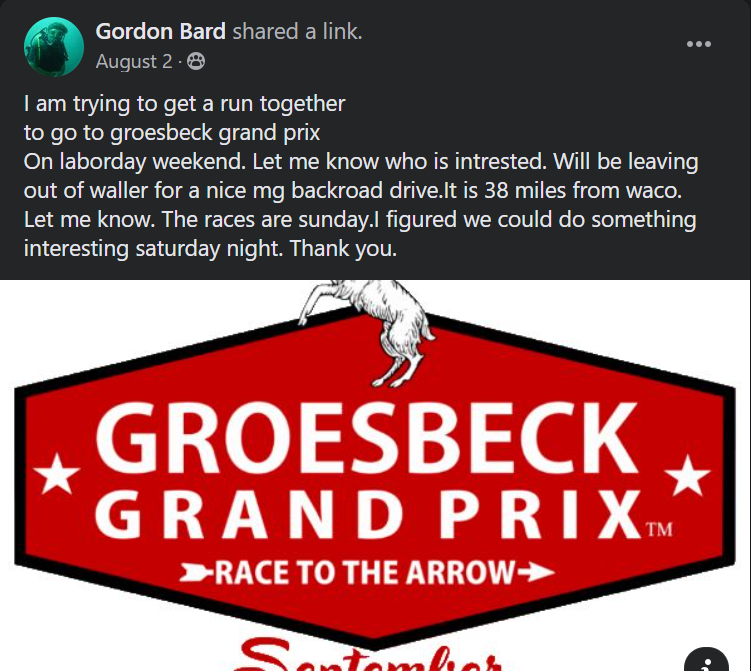 I am, admittedly, very late in writing about the wonderful trip from Houston to Groesbeck over Labor Day weekend. Not officially an HMGCC event due to Covid, this trip started with a simple note on the club’s Facebook page posted by fellow member Gordon Bard. He simply posted to say he was planning to go to the inaugural Groesbeck Grand Prix and Concours and wanted to know who else was up for the trip. Before long, several club members and a few club prospects made plans to participate! We had a great time— and I’ll tell you more about that in a moment— but first I want to extend truly heartfelt thanks to Gordon and his wife Angie. Had they not put out the initial feeler, this trip would never have happened. And they went way above and beyond with great planning, including pre-checking a local hotel for availability and pricing, planning a great route, and even personally buying and making goodie bags for the participants! THANK YOU GORDON AND ANGIE. You did a phenomenal job!!
I am, admittedly, very late in writing about the wonderful trip from Houston to Groesbeck over Labor Day weekend. Not officially an HMGCC event due to Covid, this trip started with a simple note on the club’s Facebook page posted by fellow member Gordon Bard. He simply posted to say he was planning to go to the inaugural Groesbeck Grand Prix and Concours and wanted to know who else was up for the trip. Before long, several club members and a few club prospects made plans to participate! We had a great time— and I’ll tell you more about that in a moment— but first I want to extend truly heartfelt thanks to Gordon and his wife Angie. Had they not put out the initial feeler, this trip would never have happened. And they went way above and beyond with great planning, including pre-checking a local hotel for availability and pricing, planning a great route, and even personally buying and making goodie bags for the participants! THANK YOU GORDON AND ANGIE. You did a phenomenal job!!
In addition to its being a driving event, one thing that attracted me to participate was that Gordon had planned the roughly 140 mile trip with only about five miles of highway. That meant some great driving roads, and what MG driver can pass up a chance to get out on the back roads?!
By trip day, twelve people in six cars including four MGs were planning to participate:
Gordon and Angie Bard
new members Cecil and Margaret Ellis
Ken Evesson and Carol McCoin
Mike Shouse
new members Bobby and Randy Nelson
Bryce Gunthrie, friend of the Nelson brothers
Rob and Shelly Ficalora.
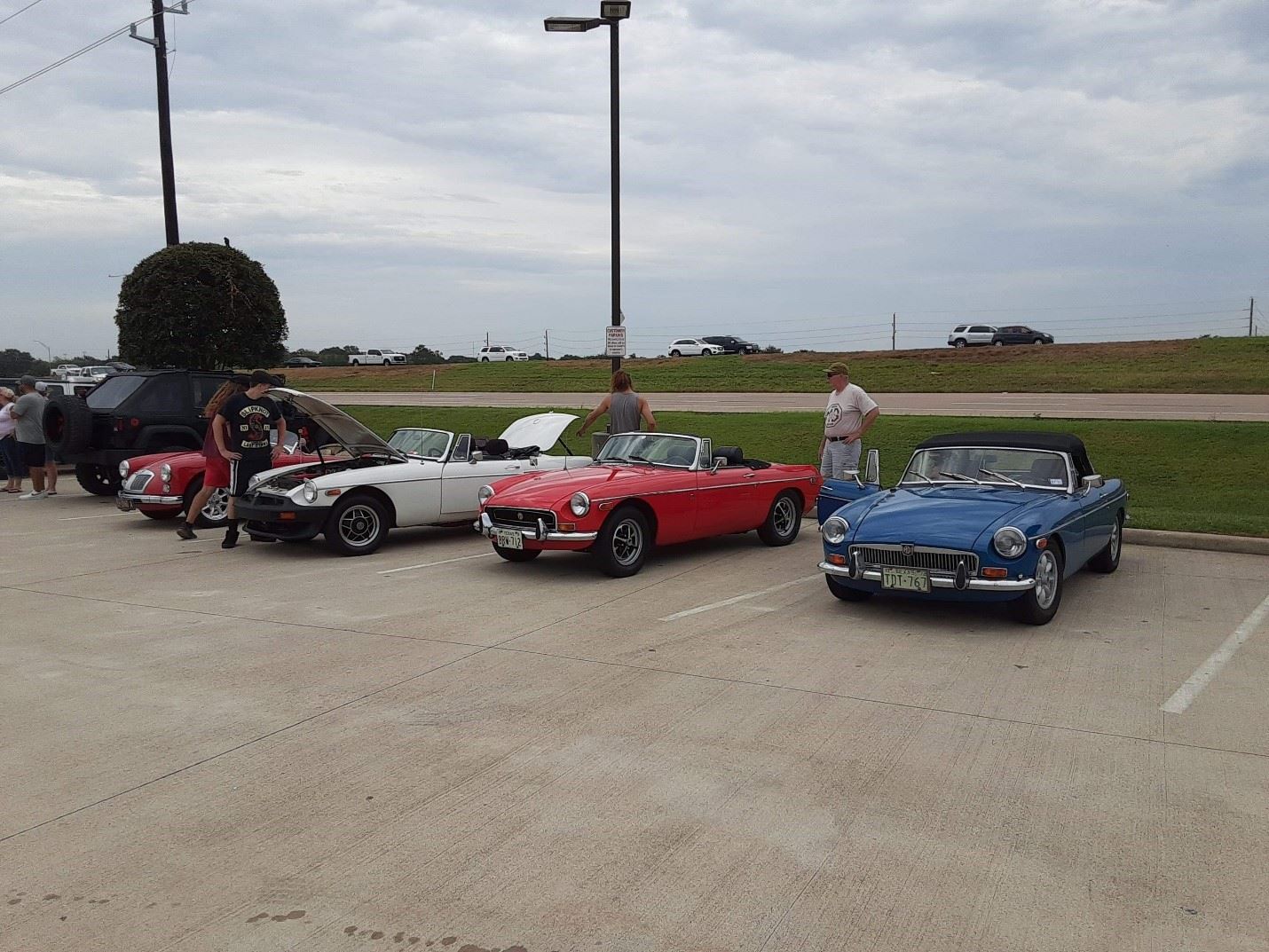 On the morning of Saturday, September 5th, the group congregated at the pre-designated Buckee’s in Cypress, a great location with ethanol-free gas for those who don’t run gas with ethanol in their cars. (NB: Ethanol can wreak havoc by deteriorating some rubber hoses and other materials and, because it absorbs water, can contribute to corrosion in the fuel system.)
On the morning of Saturday, September 5th, the group congregated at the pre-designated Buckee’s in Cypress, a great location with ethanol-free gas for those who don’t run gas with ethanol in their cars. (NB: Ethanol can wreak havoc by deteriorating some rubber hoses and other materials and, because it absorbs water, can contribute to corrosion in the fuel system.)
As trips like this go, the group had the obligatory drama, but nothing serious. One driver had to bow out at the last minute and one car wasn’t running well—a problem solved by a quick trip to a local parts store for a new fuel filter. Special thanks to Greg Fleischer who came out to see us off.
My wife, Shelly, and I live north of Houston in Willis on Lake Conroe, so rather than drive down to Cypress, we’d arranged to meet the group in Navasota at the intersection of Highway 105 and Highway 6. With some time while the group was sorting out the fuel filter issue, we had a surprise opportunity to check out downtown Navasota. We drive by there all the time going to College Station but had never explored the town. It’s a nice half-day trip from Houston with some neat shops and a great coffee shop (that had ice cream, too!).
The rest of the trip was “smooth sailing” …for the most part. About 30 minutes outside of Groesbeck, however, it was truly “sailing.” We found the rain. And, when I say rain, I mean RAIN. I mean HARD RAIN! All of our cars, were hydroplaning and Ken and his wife didn’t have a top on their car so they were getting drenched. We didn’t know them and were worried about them, so were happy when the group pulled off the road to let the heavy rain pass. I was pleasantly surprised to find they were taking it all in stride and actually having fun! I knew then we were with a couple of real adventurists– especially given that they had entered the concours and would have to dry out and clean up their car before the show the next morning. Now that I’m thinking about it, Ken, I apologize for not offering to help!! For some reason that didn’t even occur to me then but seems like a horrible oversight now!
 Once we arrived in Groesbeck, we all checked into the hotel and then headed over to the races— well, all except young guns Bobby, Randy, and Bryce, who had decided to camp out.
Once we arrived in Groesbeck, we all checked into the hotel and then headed over to the races— well, all except young guns Bobby, Randy, and Bryce, who had decided to camp out. 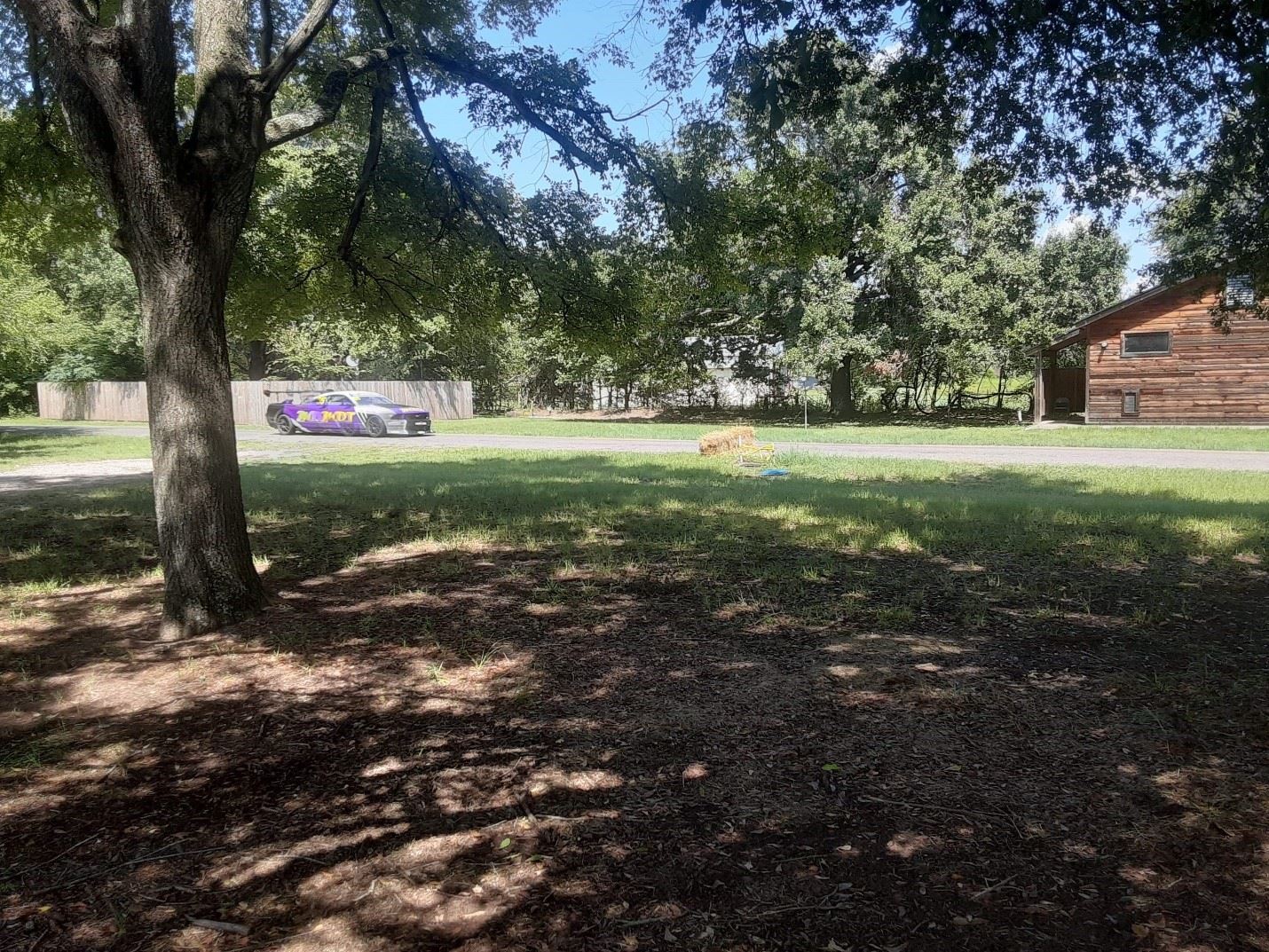 The Groesbeck Grand Prix was not your typical race where the cars are on the track at the same time. Rather, it is a timed race where the “track” was the park road at Old Fort Parker Historic Site. The cars raced against the clock with one car going at a time. There were two classes; one for vintage race cars and one for more modern cars. It was a lot of fun,
The Groesbeck Grand Prix was not your typical race where the cars are on the track at the same time. Rather, it is a timed race where the “track” was the park road at Old Fort Parker Historic Site. The cars raced against the clock with one car going at a time. There were two classes; one for vintage race cars and one for more modern cars. It was a lot of fun,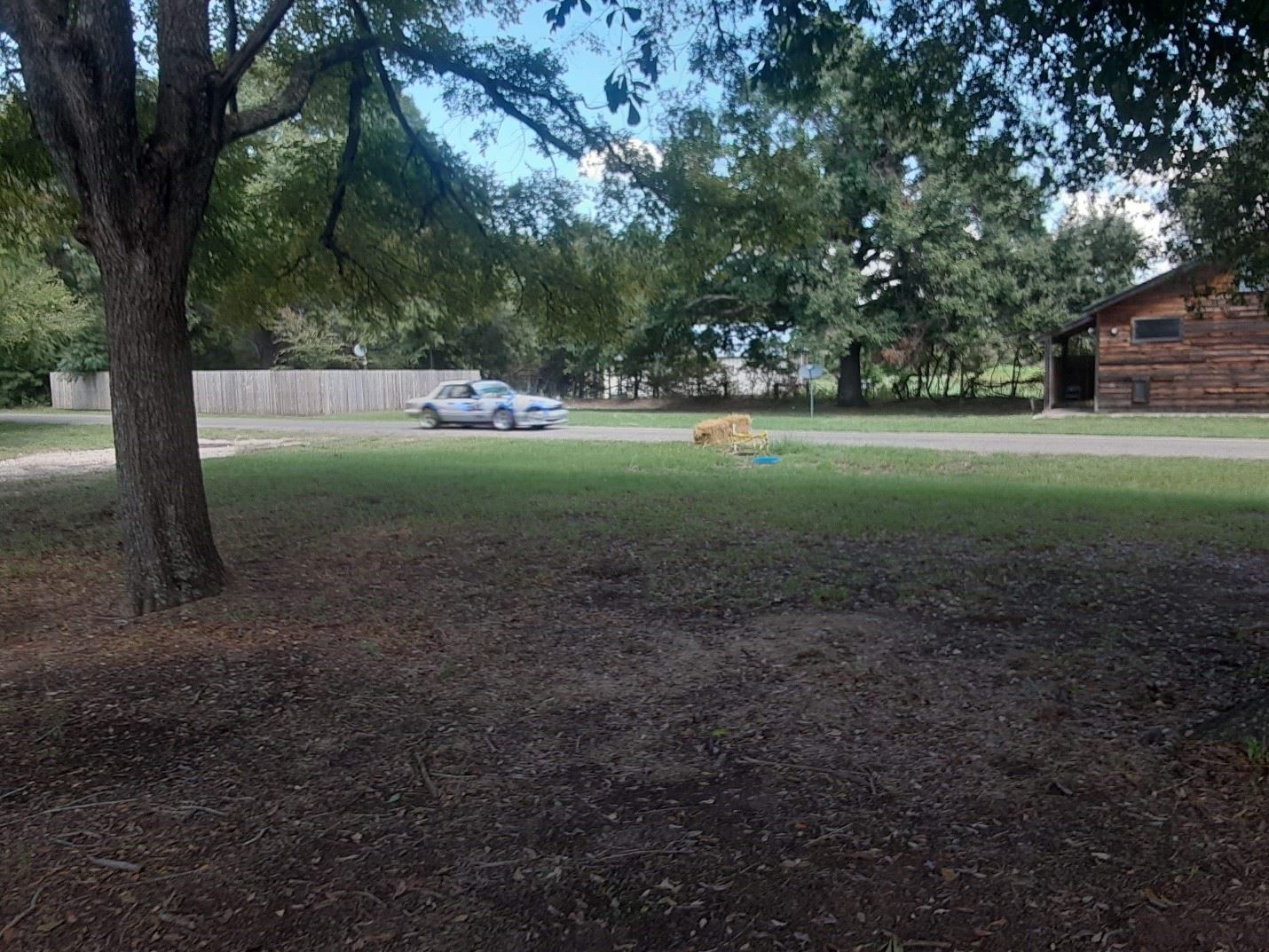 especially when we found a vantage point at the end of a long straight with a 90° curve at the end. More than one car found itself in the dirt trying to make that turn!
especially when we found a vantage point at the end of a long straight with a 90° curve at the end. More than one car found itself in the dirt trying to make that turn!
Saturday was time trials for the main event on Sunday. After watching the racing for a while, we decided it was time to go get dinner. We found a restaurant that happened to have great food. More importantly, it was a great opportunity to get to know each other in a way you never seem to have time for in one day events!
The next morning we grabbed a quick breakfast and headed over to the races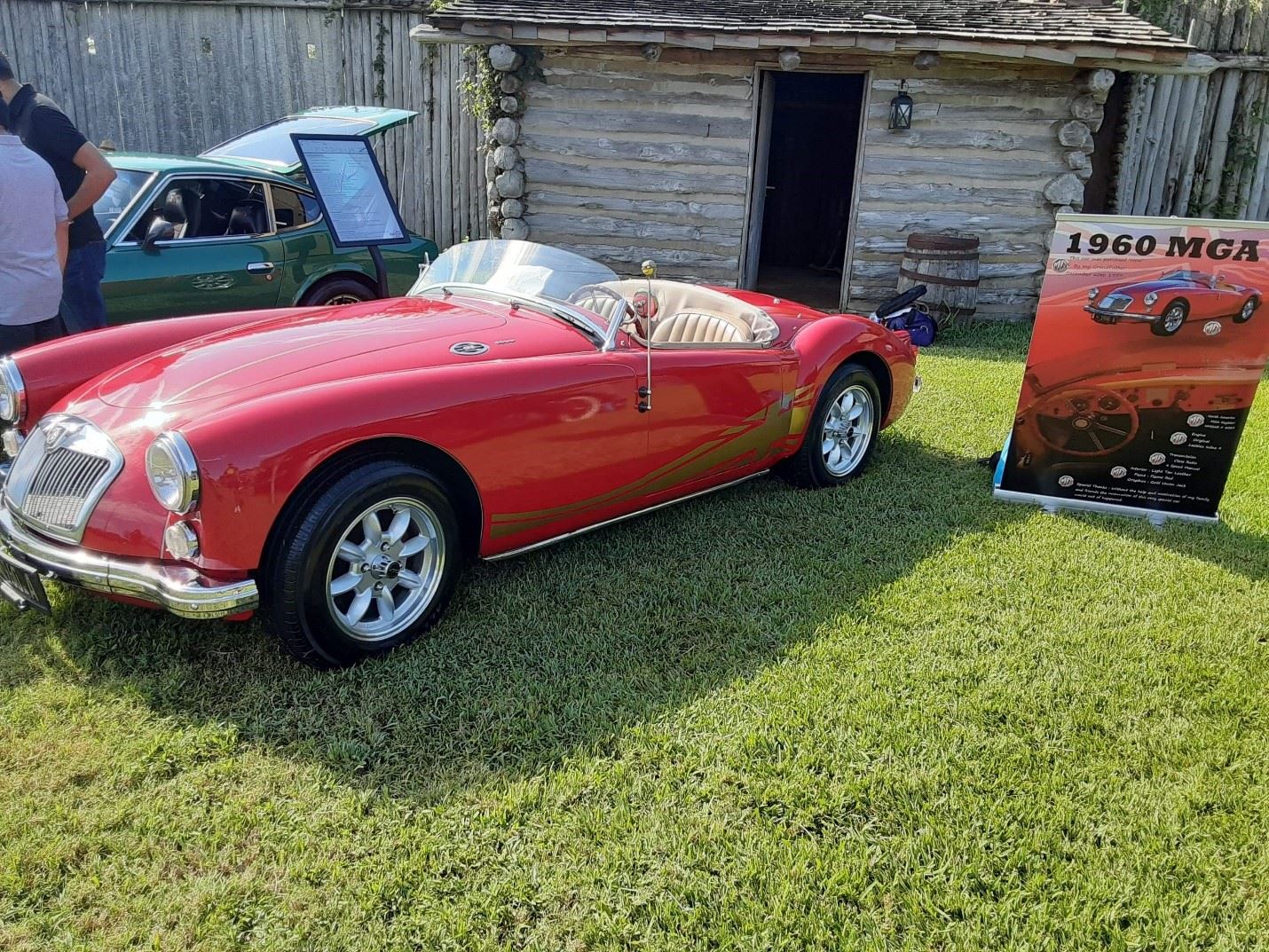 again. We made our way through the fort where the cars were displayed, and managed to find Ken and Carol. I’m not sure what time they had to get up, but I know it was early as their beautiful MGA was already on display. It was a fun time getting to know the Evessons a bit better while watching the races.
again. We made our way through the fort where the cars were displayed, and managed to find Ken and Carol. I’m not sure what time they had to get up, but I know it was early as their beautiful MGA was already on display. It was a fun time getting to know the Evessons a bit better while watching the races.
We ultimately did have to return home, and headed back at about 3pm on Sunday. Again, I can’t thank Gordon and Angie Bard enough for planning and coordinating the weekend. It was a lot of work for them to plan the overnight trip, but such an opportunity to connect with folks wouldn’t have happened if the event had been packed into one day up and back.